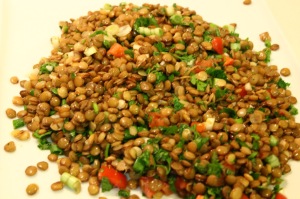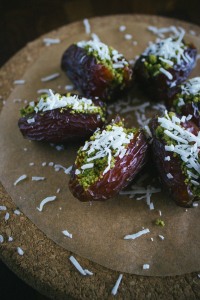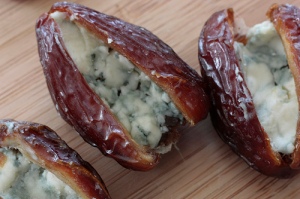The humble date often makes an appearance at Christmas – about the only time of year that you seem to be able to buy the gorgeous, sticky, squidgy Medjool style date, as opposed to the small, shrivelled, dry ones you are forced to be content with the rest of the year round!
Dates are a fruit in their own right, not the dried version of something else. Although higher in calories than most fresh fruits, they do also contain a fantastic range of nutritional benefits and so are definitely a good alternative to chocolate if you are craving something sweet this Christmas.
NUTRITIONAL BENEFITS
Fibre: dates are high in fibre which helps our digestive systems to function smoothly (pardon the pun!), prevents constipation, promotes gut health and also can help to reduce cholesterol levels in the blood.
B Vitamins: Dates contain a good amount of niacin, riboflavin and folate. These are all part of the B Vitamin family which help to support a range of bodily functions.
Riboflavin (B2): supports the health of the nervous system and can help promote skin and eye health as well as helping our bodies to release the energy from carbohydrate.
Niacin (B3): helps to promote the health of the digestive and nervous systems
Folate: helps to support Vitamin B12 to promote the production and health of red blood cells, therefore supporting the transport of oxygen to the muscles and preventing fatigue. It is also a vital vitamin during pregnancy as it prevents conditions such as spina bifida from developing in newborns.
Iron: Dates contain a decent amount of iron; any foods containing iron are good to eat as this is one of the minerals that we can so easily become deficient in, especially if we do not eat meat. Iron helps to build red blood cells which carry oxygen to muscles as a source of energy. If we are deficient in iron we can develop anaemia, a symptom of which is extreme fatigue and lack of energy.
Calcium: Dates contain a small amount of calcium, which promotes bone health, growth and development and is involved in cardiac function, so can help to keep the heart strong and healthy.
HOW TO STUFF A DATE!
Easy!
1. Slice the date down one side, being careful not to cut all the way through as you want to keep it whole.
2. Carefully remove the stone. A good treat here, as there is often some date flesh still on the stone – it’s chef’s perogative to suck the stones! Just as satisfying as licking the spoon!
3. Take one whole almond, pistachio, walnut half, cashew or a nut of your choosing and place this where the stone used to be. Alternatively, stuff the cavity with chopped nuts.
4. Roll the stuffed date in grated coconut or sprinkle some on top for a delicious treat and a beautiful festive, snowy look
5. Alternative stuffings are:
* cream cheese (low fat, if you want to keep it healthy)
* blue cheese
* thick, lowfat greek style yogurt and honey
* bacon, wrapped around the date like pigs-in-blankets (obviously the bacon needs to be cooked first)
NUTRITIONAL INFORMATION
per one date, stuffed with an almond and rolled in coconut (per one date stuffed with blue cheese)
Energy 93kcal / 389kJ (86kcal / 360 kJ)
Carbohydrate 8.1g (7.8g)
Fat 2.5g (1.5g)
Protein 1.0g (1.4g)
Sugars 8.0g (7.8g)
Saturates 1.2g (1.0g)
Fibre 1.0g (0.5g)
Salt Trace (Trace)
Serves 4

Delicious, crunchy and packed with fibre, protein, iron and folate.
With the weather starting to turn warmer, even if only sporadically and for 2-3 days out of every month in the UK, this weekend was so beautiful that it just wasn’t soupy weather! I decided to make a nice salad instead – my staple lunch during the summer months being a plate of different mixed salads like those you might see in a health food/wholefood cafe.
You can use green or brown lentils in this salad and these types are especially good in salads and casseroles because they hold their shape well after cooking (yellow and red lentils or split peas have a tendency to go mushy making them better in soups and dahls). They also lend it a really nice crunchy texture and nutty flavour which goes beautifully with the crunchy fresh veggies and parsley.
I would eat this salad as a meal on its own, maybe with a tbsp. of low fat hummus, lettuce, cucumber, cherry tomatoes and ½ pitta bread. I have eaten it on the side of a main meal such as baked fish or chicken, lasagne, moussaka or as part of a salad plate with other salads in which case I would have 1-2 tbsps. of salad rather than a large plateful. I have included the nutritional information for the whole recipe here so that you can make your own calculations if you decide to portion the salad differently; e.g. if you were to eat it on the side of a main meal rather than as a salad meal in its own right.Lentils are high in fibre, protein and a multitude of vitamins and minerals including iron, folate and calcium. They are low in fat and, because of the high fibre and protein contents, they can really help your stomach to feel fuller for longer making them a great addition to a lunch time meal as this can curb those afternoon snack cravings.
Normally you would find lentils dried and sold in bags ready for cooking although some supermarkets and specialist food stores such as south Asian supermarkets sell them already cooked in cans. I have used dried lentils so I needed to cook them – if you used canned lentils just miss out the first step and be aware that the canning process probably added extra salt to the overall nutritional content as a preservative.
Ingredients
200g dried green lentils or 2 cans cooked, drained green lentils (480g)
1 red pepper, chopped
1 green pepper, chopped
1 red onion, chopped (or equivalent amount of chopped spring onions)
1 garlic clove, finely diced
2 tbsp. fresh parsley, chopped
–
1 tbsp. olive oil
1.5 tbsp. white wine or cider vinegar
1 tsp. runny honey
2 tsp. lemon juice
Some grated lemon zest (optional)
Ground black pepper
Instructions
1. Place the lentils in a saucepan with 3 times the amount of cold water as lentils. Bring the water to a boil then reduce the heat and boil gently for 35 – 45 minutes, or until the lentils are soft but retain a bit of crunch. Remove from heat, drain off the water and allow to cool for later.
2. Finely chop the vegetables and parsley – these will stay raw so small is better unless you particularly like to eat large chunks of raw onion! Mix these together in a big bowl.
3. In a small bowl, mix together the oil, vinegar, honey, lemon juice, lemon zest (if using) and black pepper. Make sure the honey is well blended with the rest of the ingredients.
4. Pour the dressing over the vegetables and add the cooked lentils once they have cooled sufficiently.
5. Stir everything together and put the salad in the fridge for an hour or two to allow the dressing to infuse the vegetables with flavour.
NUTRITIONAL INFORMATION
per whole recipe
Energy 870 kcal / 3645 kJ
Carbohydrate 132.4g
Fat 15.4g
Protein 54.4g
Total sugar 31.7g
Saturates 3.4g
Fibre 26.0g
Salt 0.1g (check canned lentils for added salt)
NUTRITIONAL INFORMATION
per serving (if serving 4)
Energy 220 kcal / 911 kJ
Carbohydrate 33.1g
Fat 3.9g
Protein 13.6g
Total sugar 7.9g
Saturates 0.9g
Fibre 6.5g
Salt Trace (check canned lentils for added salt)
Serves 4
Stay with me, now….! It may sound strange, and that is exactly what I thought when I found the recipe in the Hamlyn book of soups and that was exactly why I had to try it out! I have an inquisitive tummy!
Also, having lived in Boston, Massachusetts for 1.5 years as a vegetarian I was anxious to try out a fishy chowder of any description as I had missed out on the Boston classic, clam chowder! Smoked fish is much easier to come by when you’re slap-bang in the middle of the North of England!
Well, I tried and I liked very much! I have since made it with 3 different types of smoked fish I had lurking in my freezer and all were equally as creamy, smoky, fragrant and delicious.
It tastes a lot like a fish pie, only the potatoes are not mashed but included in the soup so they soak up all the scrumptious smoky flavours. If you’re a fan of fish pie then I highly recommend you try this.
I have tweaked the recipe a bit, adding sweetcorn and prawns and missing out the butter which it used to fry the onion and potato to make it a little lower in saturated fat, although I imagine it does add a little something to the flavour. Parsley might be a nice addition too. If you wanted this as a main meal you could cook the potatoes separately and mash for a topping, reduce the amount of milk to around half, add in some cornflour to thicken the sauce and double the amount of fish and prawns. Nom!

Taste of the sea – smoky and delicious!
Ingredients
1 tbsp. vegetable/olive oil (10g)
2 x small-medium sized onions, peeled and chopped (220g)
350g potatoes, cut into 1cm cubes
800ml semi-skimmed milk
1 fish stock cube (10g cube)
2 bay leaves
¼ tsp. nutmeg
Black or white pepper to taste
250g smoked white fish (haddock, cod, river cobbler, etc.)

Fish Pie Soup – smoky fish, prawns, spinach and sweetcorn
150g spinach (fresh or frozen)
100g sweetcorn, canned or frozen
100g large prawns, peeled and cut in half
Instructions
- Heat 1 tbsp. oil in a large saucepan over a medium heat. Add the onion and fry for approximately 5 minutes, until softened but not browned.
- Add the diced potatoes and fry for 5 minutes, stirring regularly, until the potatoes are browned slightly.
- Add the milk, bay leaves, nutmeg and pepper.
- Place the fish fillets whole in the milk. Bring to the boil then reduce heat, cover and simmer for approximately 10 minutes.
- Remove the fish fillets and set aside until cooled. Continue to allow the milk to simmer to cook the potatoes.
- When cooled, remove any skin and bones from the fish. Flake the fish and stir it back into the milk.
- Add the spinach and sweetcorn, stirring it into the milk. If frozen simmer for 3-5 minutes until defrosted.
- Add the prawns and cook for a further 3-5 minutes.
Nutritional Information
Per Batch
Energy 1337 kcal (5594 kJ)
Carbohydrate 145.4g
Total sugars 63.4g
Fat 32.7g
Saturates 13.0g
Protein 126.0g
Fibre 12.1g
Salt 12.3g
Per Serving (Serves 4)

Smoking Fish
Energy 335 kcal (1402 kJ)
Carbohydrate 36.4g
Total sugars 15.9g
Fat 8.2g
Saturates 3.3g
Protein 31.5g
Fibre 3.0g
Salt 3.1g
Suggested Additions
A crusty roll (50g) = 130 kcal / 545 kJ
1 rasher of bacon, grilled and sliced = 80 kcal / 335 kJ
1 hard-boiled egg, peeled, chopped into 4-8 pieces = 80 kcal / 335 kJ
A moat of mashed potato, made with semi-skimmed milk (2 scoops or 120g) = 125kcal / 523 kJ
Suggested Ear Candy
I was feeling surprisingly nautical so had to stick on some Seasick Steve – gotta stick with the theme!
You Can’t Teach an Old Dog New Tricks by Seasick Steve
Seasick Steve – offical website
Of course, if you really wanted to stretch that sea-faring theme as far as possible there’s always Climie Fisher!
Love Changes Everything by ClimieFisher


